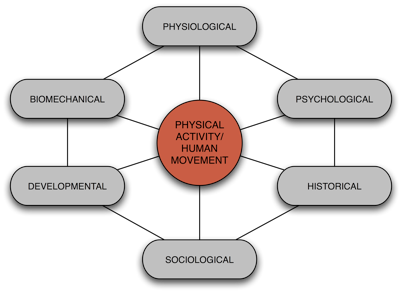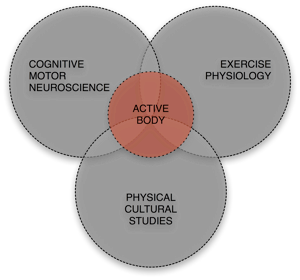The development of PCS at Maryland represents a much-needed counter to the general trend within Departments of Kinesiology (and other related fields) toward an almost exclusive focus on the bioscientific aspects and understanding of physical activity. It is our firmly held contention that particular ways of knowing the active body (particularly those anchored within the natural sciences) are presently privileged within kinesiology, thereby precluding it from realizing its potential as an epistemologically and empirically comprehensive field of inquiry. In countering this trend, our aim within PCS is to interrupt the naturalist assumptions pertaining to the body, that have allowed the human sciences to claim the body as their own. As Hargreaves noted:
“Scientific discourse and common sense combine to naturalize the ‘truth’
about the body so that its historicity and its significance in the constitution
of social relations is obscured” (1987, p. 139)
Furthering this point, the body may appear natural (an authentic expression of some biological essence), yet this masks its socio-cultural constitution, which is, at the very least, equally as important as its biological constitution. If this is true of the body in general, then it is perhaps even more applicable to the manner in which the active body is socially and culturally regulated, constructed, and experienced. As Ingham crucially noted:
“all of us share genetically endowed bodies, but to talk about physical culture
requires that we try to understand how the genetically endowed is socially
constituted or socially constructed, as well as socially constituting and
constructing” (1997, p. 176)
PCS shares a commitment to a comprehensive approach to kinesiology, whose empirical core is the complex field of physical activity/human movement, and which demands the examination of the empirical from various (inter)disciplinary vantage points. Only then is it possible to get a truly holistic understanding of the derivation, constitution, and experience of physical activity/human movement.
Figure: Kinesiology’s (Inter)Disciplinary Amalgam

Maryland’s own rendition of the kinesiology project is understandably both enabled and constrained by not inconsiderable institutional history and pressures. So, in its Maryland form, the research cultures within the Department of Kinesiology have formed into three distinct inter-disciplinary clusters (see below), each of which displays internal commonalities in terms of empirical focus, epistemological assumptions, and methodological adherence, yet each of which also recognizes the need for more imaginative approaches to cross-cluster collaboration
Figure: Maryland’s Inter-Disciplinary Kinesiological Clustering

Within this structure of inter-disciplinary clusters, and since since physical culture is both manifest and experienced in different forms, PCS adopts a multi-method approach toward engaging the empirical (including ethnography and auto-ethnography, participant observation, discourse and media analysis, and contextual analysis). PCS also advances an equally fluid theoretical vocabulary, utilizing concepts and theories from a variety of disciplines (including cultural studies, economics, history, media studies, philosophy, performance studies, sociology, and urban studies) in engaging and interpreting the particular aspect of physical culture under scrutiny.


2. The Socio-Cultural Imperative